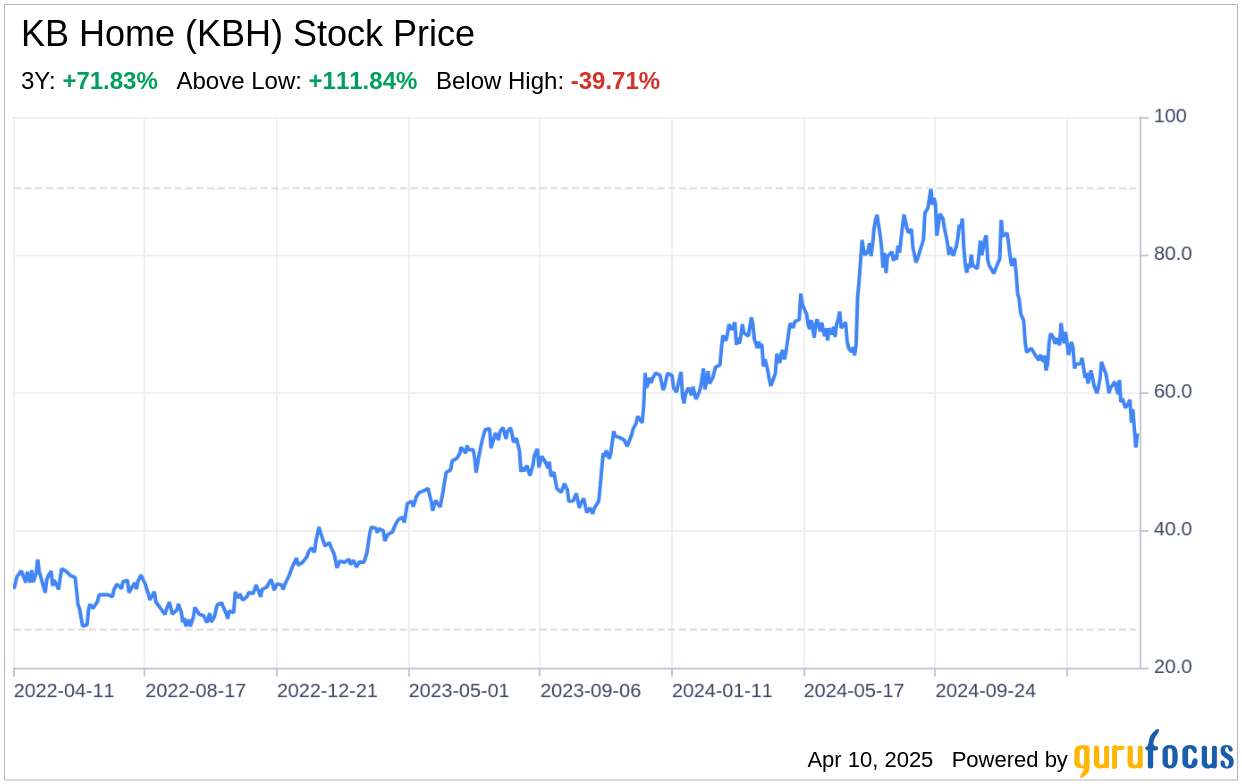KB Home (KBH, Financial), a prominent player in the American residential construction industry, has recently filed its 10-Q report on April 9, 2025. This SWOT analysis delves into the company's financials and strategic positioning to provide investors with a comprehensive understanding of its potential. The financial overview reveals that KB Home maintains a solid balance sheet with cash and cash equivalents of $48.7 million, a decrease from the previous quarter's $385.1 million. Comprehensive income stands at $109.6 million, a slight dip from the previous year's $138.7 million, reflecting the company's consistent profitability despite market fluctuations. With a focus on first-time and move-up homebuyers, KB Home's strategic investments in land acquisition and development are indicative of its commitment to future growth and expansion.

Strengths
Brand Recognition and Market Presence: KB Home (KBH, Financial) has established a strong brand presence, particularly on the West Coast, which is its primary revenue-generating region. The company's reputation for quality construction and its Built to Order business model cater to a diverse range of homebuyers, including first-time and move-up buyers. This brand strength is evidenced by the company's ability to maintain a 7% growth in community count compared to the previous year, demonstrating its ability to attract and retain customers in a competitive market.
Financial Health and Investment in Growth: The company's financial statements reflect a healthy balance sheet with significant investments in land and development, signaling a strategic focus on long-term growth. Despite a decrease in cash equivalents, KB Home has managed to sustain its comprehensive income levels. The company's joint venture in mortgage banking services also contributes to its financial stability, providing a diversified income stream and enhancing its value proposition to homebuyers.
Weaknesses
Dependence on Specific Markets: KB Home's operational and investment concentration in California and other key markets presents a risk of over-reliance on the economic health of these regions. Any downturn in these local markets could disproportionately affect the company's overall performance. This is further compounded by the company's decision to build homes that do not qualify for Section 45L tax credits, potentially impacting its competitive pricing strategy.
Increased Costs and Decreased Operating Leverage: The company has experienced a decrease in housing gross profit margins, primarily due to higher relative land costs and increased homebuyer concessions. This has led to reduced operating leverage, particularly in the West Coast segment, where the housing gross profit margin decreased by 140 basis points. Additionally, the company faces higher marketing and other expenses associated with its expanded community count, which could pressure margins if not managed effectively.
Opportunities
Strategic Land Acquisitions: KB Home's increased investments in land and land development position the company to capitalize on future housing demand. By securing desirable land parcels and efficiently developing new home communities, KB Home can expand its market presence and cater to the evolving needs of homebuyers. This proactive approach to land acquisition is crucial for sustaining growth in the highly competitive residential construction industry.
Adaptation to Market Trends: The company's focus on building highly energy-efficient homes that qualify for ENERGY STAR certification reflects an adaptation to market trends and consumer preferences. While this strategy may exclude the company from certain tax credits, it aligns with a growing demand for sustainable living solutions, potentially opening up new market segments and strengthening KB Home's brand as an environmentally conscious builder.
Threats
Regulatory and Economic Uncertainty: KB Home operates in an industry that is highly sensitive to regulatory changes and economic conditions. The recent IRS guidance on energy-efficient homes and the company's decision to forgo Section 45L tax credits exemplify the impact of regulatory shifts. Additionally, market risks such as trade policies, tariffs, and geopolitical tensions could lead to increased operational costs and supply chain disruptions, adversely affecting the company's profitability.
Market Volatility and Competition: The residential construction market is subject to cyclical fluctuations and intense competition. KB Home must navigate these challenges while managing the risk of inventory-related charges and ensuring the affordability of its homes. The company's success in converting its backlog of orders into home deliveries and revenues, particularly in its key markets, will be critical in maintaining its competitive edge and financial performance.
In conclusion, KB Home (KBH, Financial) presents a mixed picture of robust market presence and financial health, tempered by challenges in cost management and market concentration. The company's strategic land acquisitions and focus on energy-efficient homes offer promising avenues for growth, but it must remain vigilant against regulatory changes and market volatility. As KB Home continues to navigate the complex landscape of residential construction, its ability to leverage its strengths and address its weaknesses will be pivotal in sustaining its competitive position and delivering value to shareholders.
This article, generated by GuruFocus, is designed to provide general insights and is not tailored financial advice. Our commentary is rooted in historical data and analyst projections, utilizing an impartial methodology, and is not intended to serve as specific investment guidance. It does not formulate a recommendation to purchase or divest any stock and does not consider individual investment objectives or financial circumstances. Our objective is to deliver long-term, fundamental data-driven analysis. Be aware that our analysis might not incorporate the most recent, price-sensitive company announcements or qualitative information. GuruFocus holds no position in the stocks mentioned herein.
